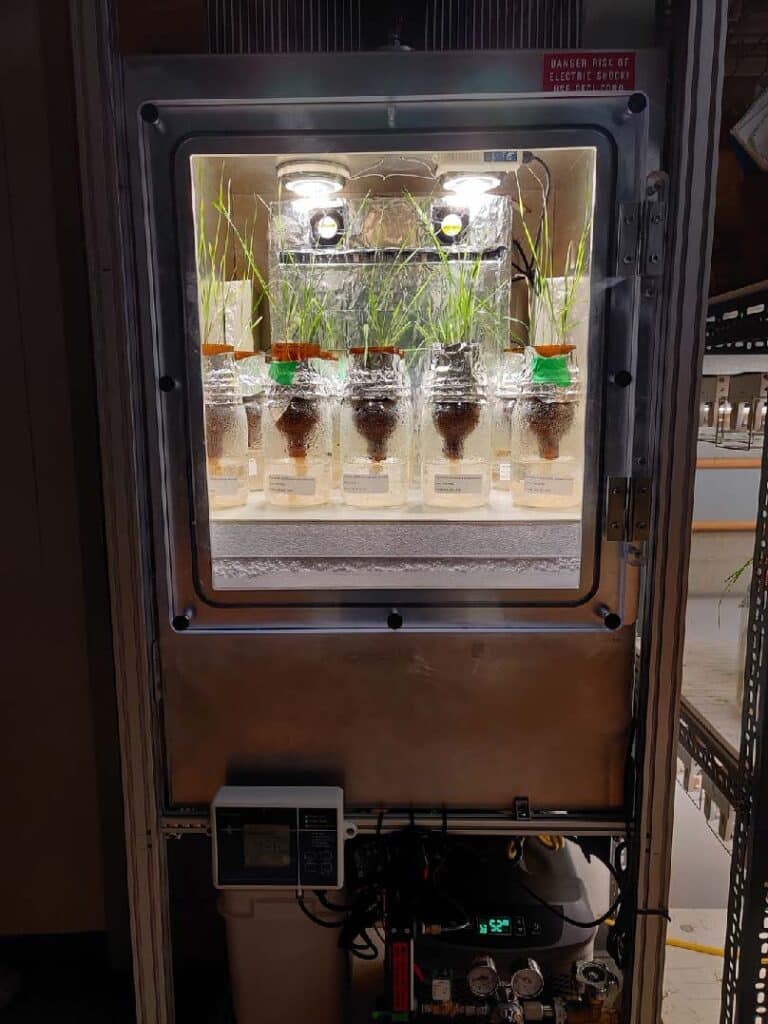Key Result
Evaluation of a commercial nitrogen-fixing bacteria product showed that the bacteria did colonize many of the root and shoot tissues, but most did not show strong evidence of nitrogen fixation. In many cases, the percentage of nitrogen in the plants that were colonized was lower than the control (not inoculated) plants.
Project Summary
Cost effective practices and products that help synchronize the supply of nitrogen with a crop’s demand for nitrogen will reduce losses and thereby reduce the amount of nitrogen fertilizer needed to produce the crop. Nitrogen-fixing organisms could, in theory, be one of those products. More work is required.

undergoing pulse labeling.
Many species of microorganisms are capable of nitrogen fixation, including Gluconacetobacter diazotrophicus (now marketed as Envita®). Unlike the rhizobia that colonize the roots of legume plants, G. diazotrophicus is a free-living organism that does not require the presence of a host plant. However, it often lives inside of plant tissues and evidence exists that it can fix atmospheric nitrogen for the associated plant and improve yield. The product has had success in crops like corn in the United States, but very little data exists on how it performs in Western Canada.
In this project, researchers tested Envita® for its ability to fix nitrogen in canola, wheat and soybean in a controlled environment. They inoculated the crops with Envita® then evaluated if the inoculated crops were acquiring nitrogen fixed by the G. diazotrophicus. To trace the path of nitrogen into the plant, they supplied 15N2 gas (labelled nitrogen for tracing in plant tissue) into the sealed chamber surrounding the plants, then analyzed plants for 15N content.
They introduced G. diazotrophicus to the plant through (1) direct seed inoculation, (2) inoculation at germination and (3) foliar application.
Results
Envita® was able to deliver G.diazotrophicus bacteria to roots and shoots of wheat, canola and soybeans, and the bacteria could colonize the tissues in most, but not all cases. However, the presence of G.diazotrophicus in the plant tissues did not always translate into 15N2 being fixed into the plant tissues.
In terms of getting G.diazotrophicus into the plant tissues, the inoculation at germination method had the most positive result followed by foliar application and direct seed inoculation. Unfortunately, application at germination is the least practical method for farmers to use, even with changes for field scale use.
Results for canola were the most inconsistent among the three crop types. All of the plants inoculated at germination showed some slight 15N enrichment in the roots and shoots, but not all tested positive for G.diazotrophicus colonization. Even though 15N enrichment indicates the transfer of 15N fixed by some means to the canola plants, there were not consistently higher percentages of nitrogen in the tissues, nor did the plants produce more biomass.
The presence of the introduced G. diazotrophicus organism in some of the tissues tested is encouraging, but further work is needed to improve colonization efficacy and to determine how to trigger the organism to fix nitrogen after it has colonized.





